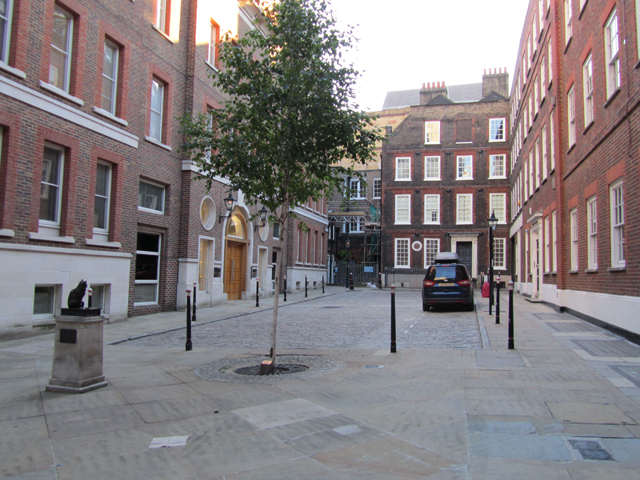Gough Square (City of London)
Brief Description
Gough Square was originally laid out in the late C17th by a family of that name. No. 17 Gough Square is famous for being the house where Dr Samuel Johnson lived between 1748-59 and where he compiled his Dictionary. In 1911 the house was restored as a museum with a Curator's House to the south, a small garden between the two buildings. The north and east sides of Gough Square were rebuilt in the 1950s and further refurbishment took place in the 1990s; the square is paved with granite setts, with one tree, reproduction gas-lights and C19th and C20th cast-iron bollards, with a covered carriageway in the north-west corner. A bronze sculpture of Johnson's cat 'Hodge' on a stone pedestal was erected in 1997.
Practical Information
- Site location:
- Gough Square, access from Pemberton Row
- Postcode:
- EC4A 3EA
- What 3 Words:
- putty.meals.tube
- Type of site:
- Square
- Borough:
- City of London
- Open to public?
- Yes
- Opening times:
- unrestricted
- Special conditions:
- Facilities:
- Events:
- Public transport:
- Tube: Blackfriars (District, Circle); Chancery Lane (Central). Bus: 4, 11, 15, 26, 76, 341
- Research updated:
- 01/06/2010
- Last minor changes:
- 19/07/2023
Please check with the site owner or manager for latest news. www.cityoflondon.gov.uk
Full Site Description
Gough Square was originally laid out in the late C17th part of housing development by a family of that name. Nearby was Holy Trinity Church built in 1838-42 as a daughter church of St Bride's Fleet Street (q.v.) but sold in 1880 and demolished in 1906 when parish was re-united with that of St Bride. No 17 Gough Square is famous for being the house where Dr Samuel Johnson lived between 1748 and 1759 and where he compiled his Dictionary, working in the attic; in 1911 the house was restored as a museum to Dr Johnson by Alfred Burr who also built the Curator's House to the south with a small garden between the two buildings. The north and east sides of Gough Square were rebuilt in the 1950s and further refurbishment took place in the 1990s; the square is paved with granite setts, with one tree, reproduction gas-lights and C19th and C20th cast-iron bollards, with a covered carriageway in the north-west corner. A bronze sculpture of Johnson's cat 'Hodge' on a stone pedestal was erected in the square in 1997.
Sources consulted:
Simon Bradley & Nikolaus Pevsner, 'The Buildings of England, London 1: The City of London', 1997 (1999 ed.); London Diocesan Advisory Committee for the Care of Churches data
Further Information (Planning and Conservation)
- Grid ref:
- TQ313812 (531390,181266)
- Size in hectares:
- 0.05
- Site ownership:
- City of London Corporation
- Site management:
- Dept. of Technical Services
- Date(s):
- C17th; 1990s
- Designer(s):
- Listed structures:
- LBI: Dr Johnson's House No 17 Gough Square. LBII: No 16 Gough Square
- On National Heritage List for England (NHLE), Parks & Gardens:
No- Registered common or village green on Commons Registration Act 1965:
No- Protected under London Squares Preservation Act 1931:
No
Local Authority Data
The information below is taken from the relevant Local Authority's planning legislation, which was correct at the time of research but may have been amended in the interim. Please check with the Local Authority for latest planning information.
- On Local List:
- No
- In Conservation Area:
- Yes
- Conservation Area name:
- Fleet Street
- Tree Preservation Order:
- No
- Nature Conservation Area:
- No
- Green Belt:
- No
- Metropolitan Open Land:
- No
- Special Policy Area:
- No
- Other LA designation:
- Strategic Viewing Corridor
Please note the Inventory and its content are provided for your general information only and are subject to change. It is your responsibility to check the accuracy.









